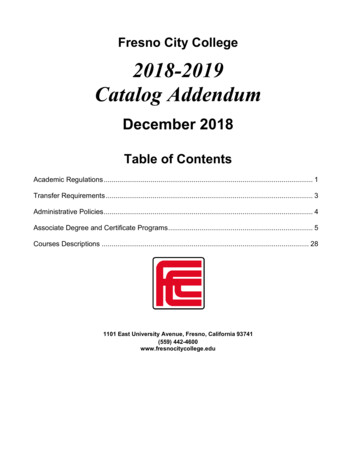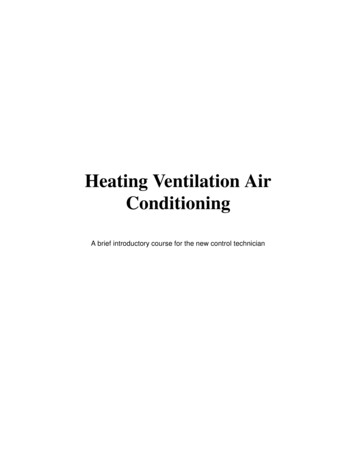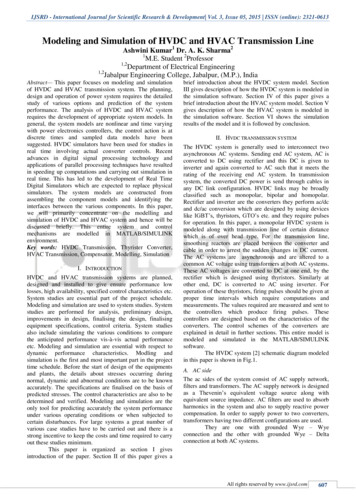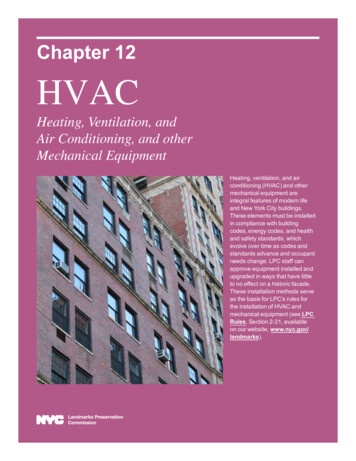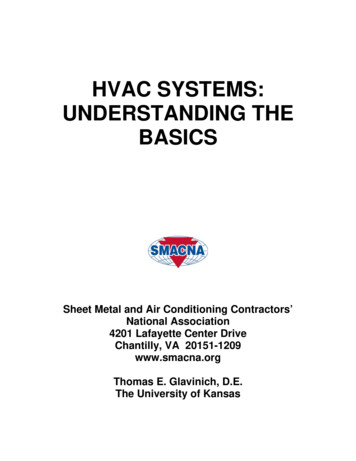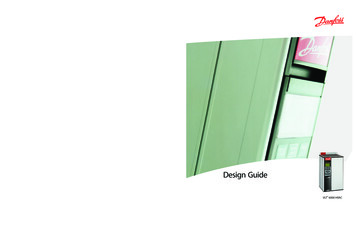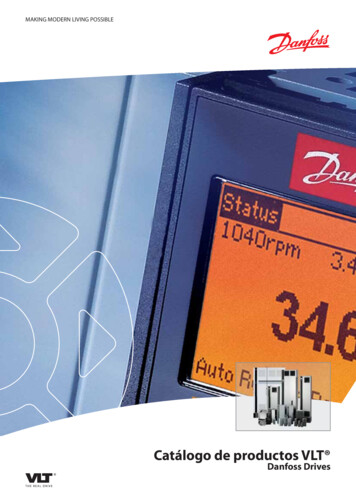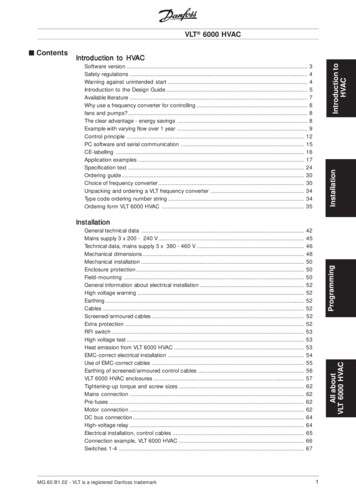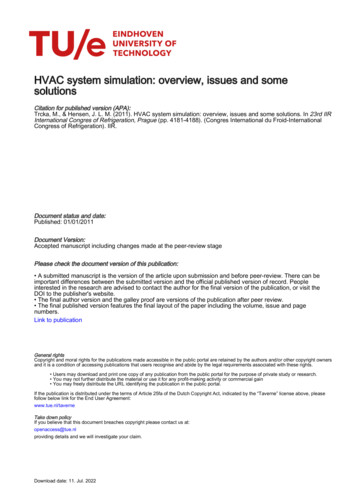
Transcription
HVAC system simulation: overview, issues and somesolutionsCitation for published version (APA):Trcka, M., & Hensen, J. L. M. (2011). HVAC system simulation: overview, issues and some solutions. In 23rd IIRInternational Congres of Refrigeration, Prague (pp. 4181-4188). (Congres International du Froid-InternationalCongress of Refrigeration). IIR.Document status and date:Published: 01/01/2011Document Version:Accepted manuscript including changes made at the peer-review stagePlease check the document version of this publication: A submitted manuscript is the version of the article upon submission and before peer-review. There can beimportant differences between the submitted version and the official published version of record. Peopleinterested in the research are advised to contact the author for the final version of the publication, or visit theDOI to the publisher's website. The final author version and the galley proof are versions of the publication after peer review. The final published version features the final layout of the paper including the volume, issue and pagenumbers.Link to publicationGeneral rightsCopyright and moral rights for the publications made accessible in the public portal are retained by the authors and/or other copyright ownersand it is a condition of accessing publications that users recognise and abide by the legal requirements associated with these rights. Users may download and print one copy of any publication from the public portal for the purpose of private study or research. You may not further distribute the material or use it for any profit-making activity or commercial gain You may freely distribute the URL identifying the publication in the public portal.If the publication is distributed under the terms of Article 25fa of the Dutch Copyright Act, indicated by the “Taverne” license above, pleasefollow below link for the End User Agreement:www.tue.nl/taverneTake down policyIf you believe that this document breaches copyright please contact us at:openaccess@tue.nlproviding details and we will investigate your claim.Download date: 11. Jul. 2022
Trcka, M. and Hensen, J. L. M., 2011. HVAC system simulation: overview, issues and some solutions.Proceedings of the 23rd IIR International Congress of Refrigeration, Prague , 21-26 August,International Institute of Refrigeration, pp. 8.ID: 923HVAC SYSTEM SIMULATION: OVERVIEW, ISSUES AND SOMESOLUTIONSTRCKA M., HENSEN J.L.M.Eindhoven University of Technology, Den Dolech 2, PO Box 513, 5600MB, Eindhoven, The Netherlandsm.trcka@tue.nlABSTRACTIntegrated performance simulation of buildings’ heating, ventilation and air-conditioning (HVAC) systemscan help in reducing energy consumption and increasing occupant comfort. Recognizing this fact, in the lastforty years many tools have been developed to help achieving this goal. In this paper we introduce acategorization of these tools with respect to which problems they are meant to deal with and summarizecurrent approaches used for modelling (i) HVAC components, (ii) HVAC control and (iii) HVAC systems ingeneral. Further in this paper, we list issues associated with applications of HVAC modelling and simulation.Finally, we present and discuss co-simulation as one of solutions that can alleviate some of the recognizedissues.1.INTRODUCTIONModern buildings are required to be energy efficient while adhering to the ever increasing demand for betterindoor environmental quality. It is a known fact that in developed countries buildings account for 30%-40%of the energy consumed. Depending on the building type, heating, ventilation and air-conditioning (HVAC)systems are responsible for 10%-60% of the total building energy consumption. The long life-cycle ofbuildings further compounds the importance of architectural and engineering design decisions.On the one side, challenging goals are set by new initiatives and energy policies. For example, the EuropeanUnion has defined ambitious goals for reducing emission of CO2 for the industrialized countries. Also, theU.S. Department of Energy and ASHRAE have defined their vision for 2030 [ASHRAE 2008] in a form ofnet zero energy buildings. On the other side, new buildings consist of numerous dynamically interactingcomponents that are nonlinear, dynamic, and complex. This requires an integrated approach that treatsinnovative solutions to buildings and the systems that service them as complete entities, not as separatelydesigned subsystems.To design energy efficient building systems in this complex setting, integrated building performancesimulation (BPS) can be used. Experience shows that BPS can indeed result in a significant reduction ofemission of greenhouse gases, and give substantial improvements in comfort levels [Hensen et al. 2004].Forty-year long development of BPS tools resulted in a wide range of currently available products [DOE2009; Crawley 2005]. These products range (complexity-wise) from spreadsheet tools to more advancedspecial-purpose simulation tools, and (integration-wise) from tools that handle a single aspect of the buildingdesign, to tools that integrate multiple aspects of the building design [Hensen 2009].Starting from the first generation of BPS tools based on simplified methods found in handbooks, the BPStools have evolved into fully integrated tools. The number of currently available BPS tools and diversity ofaspects taken into account in those tools and modelling approaches used by those tools makes writing ageneral overview of the field a difficult task. Thus, this paper is restricted to an overview of modelling andsimulation developments in one of the more important subsystems in buildings: heating, ventilation and airconditioning (HVAC) systems.2.TOOLS FOR HVAC SYSTEM DESIGN AND ANALYSISTools for HVAC design and analysis can be categorized with respect to the problems they are meant to dealwith. Although these problems are not mutually exclusive, and some tools can handle several problems, theydo tend to be investigated in isolation from each other. The categories are as follows [Trcka and Hensen2010].
Tools for pipe/duct sizing are system design tools that consider flow distribution and sizing ofliquid/air distribution system (e.g. AFT Fathom, DOLPHIN, DUCTSIZE, Pipe-Flo, PYTHON).Tools for equipment sizing and selection offer automatic HVAC equipment sizing (e.g. CarrierHAP, Trane, TRACE 700, EnergyPlus).Tools for energy performance analysis are designed to predict the annual energy consumption ofan HVAC system. Based on a system of equations that define thermal performance of buildings andsystems, and with given boundary conditions, operation strategy and controls, these tools perform(hourly or sub-hourly) simulations (e.g. EnergyPlus, ESP-r, IDA ICE, TRNSYS, VA114, SIMBAD).These tools are typically used to calculate and analyze the full- and part-load performance, toanalyze system operation strategy, to compare different design alternatives, etc. [e.g. Jokisalo et al.2009, Stadler et al. 2006]Tools for system optimization are used in conjunction with tools for energy performance analysis.In multiple simulation runs, a set of parameters is optimized according to a given objective function.An example is the generic optimization tool GenOpt [Wetter 2001].Tools for control analysis and control optimization. The level of HVAC system control modellingand simulation in the available tools varies:o Controllers can be associated with high abstraction system models, such as in ESP-r.o Controllers can be represented explicitly either as models of supervisory control, such as in EnergyPlus, or as simple models of local control, such as in ESP-r and TRNSYS.o More advanced representation of controllers, such as fuzzy logic, are available in e.g.MATLAB based tools (SIMBAD), Dymola and tools coupled to MATLAB (ESP-r[Yahiaoui et al. 2003], TRNSYS [CSTB 2003]). These tools are efficient for design andmore comprehensive testing of controllers in a simulation setting [Jreijiry et al. 2003], aswell as for testing and validation of controller design in real time [Riederer 2005].Simulation tools for real-time performance optimization. Benefits of using simulation tools in thebuilding operational stage are still insufficiently explored. Simulation tools could be used for:o Commissioning diagnostics (initial commissioning): i.e. to verify the performance of thewhole building, its subsystems and components [IEA-ANNEX40 2004];o Monitoring diagnostics (continuous commissioning) and fault detection diagnostics: i.e. todetect, analyze, locate and/or predict problems with systems and equipment occurring duringeveryday operation [e.g. Hyvikinen 1996, Haves et al. 1998, 2001].o Emulating a building and its HVAC systems: i.e. simulating the response of a building andits HVAC systems to building energy management system (BEMS) commands. Emulatorscan also be used for control product development, training of BEMS operators, tuning ofcontrol equipment and imitating fault situations to see how the BEMS would cope [Clarke etal. 2002];o Simulation assisted control: i.e. to execute a simulation model (encapsulated within theBEMS) as part of the control task in order to evaluate several possible control scenarios andmake a choice in terms of some relevant criteria [Clarke et al. 2002].The system simulation models that belong to this category are expected to predict systemperformance accurately. Thus, they need to be able to treat the departures from ideal behaviourthat occur in real systems and to realistically model controls and HVAC system dynamics. Thetools for energy performance analysis can be used as tools for real-time optimization of systemperformance [Zheng and Pan 2007], but models of a building and its systems need to be wellcalibrated [Reddy 2007a]. In general, well calibrated first-principle models can be used [Reddy2007b], but simpler and precise empirical models can be used as well.3.MODELLING APPROACHES3.1. Modelling approaches for HVAC componentsAccording to Zeigler [1976], the majority of models (some exceptions exist) in building and systemperformance simulation are continuous in state, discrete in time, deterministic, time varying, both steadystate and dynamic. There exist both forward and backward models. The former are used to predict theresponse of output variables based on a known structure and known parameters when subjected to input andforcing variables. The latter tend to be much simpler but are relevant only for cases when system-specific
and accurate models of specific building components are required, e.g. for fault detection and diagnosis[Hyvikinen 1996].There is a distinction between primary and secondary HVAC system components. The former are sometimesreferred to as plant, and the latter are referred to as system. A primary system converts fuel and electricityand delivers heating and cooling to a building through secondary systems. In both primary and secondarysystems there are two types of components: distribution components and heat and mass balance components.The distribution components models should satisfy energy and mass balance equations. Most of thesimulation tools model distribution components in a simplified way [ASHRAE 2009], which eliminates theneed to calculate the pressure drop through distribution system at off-design conditions. In general, thisapproach is sufficiently accurate for studying temperatures in the system. For detailed analysis of e.g.fan/pump control loops and for answering questions related to the placement of the return/exhaust fan, typeand size of dampers/pipes, flow and pressure balancing between the components is necessary [Haves et al.1998].The above heat and mass transfer components of secondary systems are usually described by forwardmodelling using fundamental engineering principles. The components of primary systems, due to theircomplexity, are described by empirically obtained equations, i.e. by using regression analysis of design datapublished by a manufacturer, or by simply specifying look-up tables.3.2. Modelling approaches for HVAC controlHVAC controllers can be divided into two categories: local controllers and supervisory controllers. Theformer are low level controllers that allow HVAC systems to operate properly and to provide adequateservices and the latter are high level controllers that allow complete consideration of the system levelcharacteristics and interactions among all components and their associated variables. From a modelling pointof view, controllers are represented by equations that must be satisfied in every simulation step. Thecontrollers direct the interaction between building and system as well as interactions between componentswithin the system. In reality, the closed-loop local-process control includes a sensor that samples a real world(measurable) variable. The controller, based on the set point value and measured value, and according to thecontroller-specific control algorithm, calculates the control signal that feeds the real world actuator.However, in the simulation tool the user can address variables that can not be sensed or actuated in reality, aswell as apply control algorithms that do not exist in reality. For example, a modeller can directly actuate theheat flux in a model where in reality this could only be done indirectly by changing a valve/damper position.Furthermore, due to the accessibility of many variables not directly known in the real world, such as the zonecooling/heating load, in simulation the concept of ‘ideal’ (local process) control becomes feasible. An ‘ideal’local process controller means that the actuated variable will be adjusted to satisfy the set point requirementsfor the controlled variable, without specifying the explicit control algorithm and by numerically inverting the(forward) simulation models (from the required output calculate the input needed to satisfy this).Possibilities to simulate different (advanced) controllers in state-of-the-art BPS tools are limited. Some toolsoffer predefined control strategies, some offer flexibility in specifying only supervisory controllers(EnergyPlus) and some even in specifying local controllers (TRNSYS, ESP-r). The domain-independentenvironments, such as MATLAB and Dymola, are efficient tools for designing and testing of controllers in asimulation setting, but lack the models of all other physical phenomena in buildings.3.3. Modelling approaches for HVAC systemsHensen [1996] defines four categories of HVAC system representation in BPS tools, ranging from purelyconceptual towards more explicit. Pure conceptual system modelling approach represents the case whereonly room processes are considered, while all other processes in primary and secondary systems areidealized, with a possibility to impose a capacity limitation upon them. An example application is to use thepredicted room cooling/heating peak loads to determine the required HVAC system size. Most state-of-theart BPS tools can be used to model systems using this approach.System-based modelling approach represents the case with preconfigured common system types, such asvariable air volume system and constant-volume variable-temperature system. The user has flexibility inspecifying capacities, system flow rates, efficiencies and off-design system component characteristics, but isrestricted to the system configurations and control strategies that are predefined in the tool. This modellingapproach is implemented in e.g. DOE-2, eQUEST, and DesignBuilder.
Component-based system modelling approach represents the case where a system is specified by (a)network(s) of interconnected component models. This approach is more flexible in terms of possible systemconfigurations and control strategies compared to the previous approach.Component-based multi-domain system modelling approach represents the case where componentrepresentation is further partitioned into multiple interrelated balance concepts, e.g. fluid flow, heat andelectrical power balance concepts. Each balance concept is then solved simultaneously for the whole system.As an addition to the above four categories defined by Hensen [1996], Trcka and Hensen [2010] lists a fifthcategory: the equation-based system modelling approach. This modelling approach represents the case wherea system is represented by a basic modelling unit that is physically ‘smaller’ than a component and that is inthe form of an equation or a low-level physical process model. It has evolved from the need to improve theBPS tools that had been based on technology available in the early seventies [Sahlin et al. 2003]. Examplesof equation-based tools are: SPARK (Simulation Problem Analysis and Research Kernel) [LBNL 2003],NMF (Neutral model format), IDA [Sahlin 2004], and Modelica [Tiller 2001].3.4. Solution techniques for HVAC system simulation modelsThe differences in solution techniques employed by different simulation tools are based on the distinction inthe way the integrator is employed [Hillestad and Hertzberg 1988]. Simultaneous modular solution, where the various components are integrated simultaneously by acommon integrator. In general, the tools that employ this solution technique use model equationsthat are based on first principles [Hillestad and Hertzberg 1988]. Independent modular solution, where each module is provided with individual integrator routines.The component's modules encapsulate all information relevant to the component's simulation modelsetting and execution. In general, the tools that employ this solution technique use model equationsthat can be based on first principles but can also be empirical input/output correlations [Hillestad andHertzberg 1988]. Each component is executed sequentially and the system solver iterates until aconvergent solution has been found. Equation-based solution using formula manipulation, which has emerged in recent years with thedevelopments of equation-based tools. Models composed with these tools cannot be executeddirectly. To be executed, a model needs to be transferred into a programming language that can becompiled [Sowell and Haves 1999].4.INTEGRATION OF BUILDING AND HVAC SYSTEM MODELSThe integration of building and HVAC system models is accomplished at different levels. The models can be(i) sequentially coupled (e.g. BLAST, DOE-2) – without system model feedback to the building model or (ii)fully integrated (e.g. ESP-r, EnergyPlus, IDA ICE, TRNSYS) - allowing the system deficiencies to be takeninto account when calculating the building thermal conditions. Levels of detail of both building and systemmodels can vary from simple (e.g. the bin method and pure conceptual representation for system model) tocomplex (numerical model of physical processes).5.ISSUES IN MODELLING AND SIMULATION OF HVAC SYSTEMSEven though the available tools for HVAC system design and analysis cover a wide range of design andoperational problems, there is still an enormous amount of work to be done in this area. Some requirementsfor further research and development are: Buildings are complex systems of which the real performance usually deviates from the performancepredicted in the design stage. Recent studies, e.g. [Elkhuizen and Rooijakkers 2008], show that thedifference between the predicted and real energy consumption can be up to 40%. For crude analysis,including the relative comparison of the design alternatives, this may not be a problem. However, tobe able to correctly base design decisions on predictions, there is a need to understand where theabove discrepancies come from and to include the uncertainties in the system model. Although some design problems immediately exclude the use of some tools, the user is still free tochoose between a large numbers of available tools for a particular case. So far, there is nocomprehensive guideline on how to make this choice relative to the required accuracy of thepredictions based on the model.
Simulation tools have been seen as promising tools for establishing the baseline performanceprediction which can be used during building operation to monitor the performance and/or to detectand identify abnormalities in the system behaviour. However, the research is still in its early phases. The capability of most of the tools is limited to a set of predefined system configurations. Tosuccessfully continue the development of BPS tools the focus should be on supporting flexiblemodelling environments that allow analyzing building systems which are not yet covered in currentBPS tools.In the following section we continue by presenting co-simulation as a promising approach to alleviate at leastthe last barrier from the above list. 6.CO-SIMULATIONTo successfully continue the development of the BPS tools that accelerates innovation of buildingtechnologies that help in mitigating climate change, a focus should be on supporting a flexible modellingenvironment that allows analyzing building systems that have not yet been implemented by the programdevelopers. A way forward would be to provide a facility to combine features from different tools, sharingdevelopments and reusing component models. A tool should be coupled with a complementary tool in such away that the integrated result provides more value to the end user than the individual tool does itself. Thiscan be achieved by integration of physical process models by linking applications at run-time. The strategy isknown as process model cooperation [Hensen et al. 2004], external coupling [Djunaedy 2005], or cosimulation [Wetter and Haves 2008; Trcka 2008]. Co-simulation is a case of simulation scenario where atleast two simulation tools solve coupled differential-algebraic systems of equations and exchange data duringthe time integration in order to couple these equations. In general, compared to the traditional, monolithicapproach, co-simulation has several advantages: It facilitates reuse of state of the art BPS tools by taking advantages of existing models; It allows combining heterogeneous solvers and modelling environments of specialized tools; It enables fast model prototyping of new technologies; It facilitates collaborative model design and development process; It makes immediate access to new model developments; It permits information hiding, i.e., use of proprietary tools.However, these flexibilities can pose numerical challenges, and to scale the use of co-simulation to a largecommunity of building designers requires more research and development. Co-simulation has beensuccessfully applied in different fields, such as aerospace and automotive [ADI 2010], high performancecomputing, defence and internet gaming [Fujimoto 2003], chemistry [Hillestad and Hertzberg 1988] andaerodynamics, structural mechanics, heat transfer and combustion [Follen et al. 2001; Sang et al. 2002].In the field of BPS, considerable effort has been made in integrating coupled physical phenomena into theindividual BPS tools (e.g., ESP-r, EnergyPlus, IES VE, IDA ICE, TRNSYS). Some of the integrated BPStools integrate process models by converting models available in other tools into their own subroutines.Examples of such integrations are the coupling between ESP-r and TRNSYS [Hensen 1991; Wang andBeausoleil-Morrison 2009], COMIS and EnergyPlus [Huang et al. 1999], COMIS and TRNSYS [McDowellet al. 2003], EnergyPlus and MIT-CFD [Zhai 2003], EnergyPlus and Delight [Carroll and Hitchcock 2005],and EnergyPlus and SPARK [LBNL 2003].However, only a limited amount of work has been done in process model co-operation (co-simulation).Examples of such integration include the integration of high-resolution light simulation (Radiance) withbuilding energy simulation (ESP-r) [Janak 1999], the integration of computational fluid dynamics simulation(FLUENT) with building energy simulation (ESP-r) [Djunaedy 2005], which was extended to includemoisture by Mirsadeghi et al. [2009], and the integration of heat air and moisture envelope simulation withbuilding energy simulation (ESP-r) [Costola et al. 2009]. In the domain of HVAC simulation tools examplesinclude integration of TRNSYS with several other programs, such as MATLAB [CSTB 2003] and EES[Keilholz 2002]. The recent work [Trcka et al. 2010] illustrates more comprehensive co-simulationframework which has been proven to be stable, consistent and thus convergent. The framework has beenimplemented using EnergPylus and TRNSYS. Similar architecture has been implemented in the BuildingControls Virtual Test Bed (BCVTB) [Wetter and Haves 2008].The co-simulation strategy in comparison with other strategies that enable sharing of developments andreusing existing component models [Hensen et al. 2004] is presented in Figure 1. The coupled models are
independently created and the results are analyzed separately, while the simulators are coupled at run-time,exchanging data in a predefined manner. In comparison to process model interoperation, co-simulationenables immediate use of the component models developed in different tools (providing that the tools areopen for communication). Once developed and implemented the general co-simulation interface between thesimulators can be used without any code adaptation, which is necessary in any other tool integration strategy.Using co-simulation for BPS can be beneficial since: There is no single tool that can be used to solve all simulation analysis problems encountered bydesigners. Each tool can benefit from future simulation model developments of emerging technologies as soonas they become available. Rapid prototyping of new technologies, which is difficult in the state of the art domain tools, couldbe done using an equation-based simulation tool. When used in co-operation with whole buildingenergy analysis programs, it would assure the integrated approach to building and systemssimulation. Multi-scale modelling and simulation can be done by combining various building and systemmodels, developed by different parties, to simulate scenarios on the scale of a town or even regions.7.IN CONCLUSIONThis paper presents an overview of available tools for HVAC system design and analysis, modellingapproaches and simulation techniques. The numerous available tools range from simple spreadsheet tools tomore advanced simulation tools. Even though they cover a wide range of design and operational problems,there is still an enormous amount of work to be done in this area. We identified some requirements forfurther research and development and presented co-simulation as one approach that ca alleviate some of therecognized issues. A benefit of a co-simulation environment is that domain-specific tools can be coupled foran integrated simulation while preserving their individual features. It therefore enables the following:1. Use of disparate tools that support individual domains. For example, the EnergyPlus building modelmay be used as it allows modelling daylight availability in rooms, while TRNSYS may be used as itallows a graphical, flexible modelling of the mechanical system;2. Development of control algorithms in tools like MATLAB/Simulink or LabVIEW, which providetoolboxes for designing controllers, as well as code generation capabilities to translate a simulationmodel to C code that can be uploaded to control hardware;3. Development of control algorithms in tools that allow a richer semantics for expressing modelscompared to what can be found in typical building simulation programs. For example, thecomplexity of large control systems can be managed using a hierarchical composition in which finitestate machines define the states and their transition at the supervisory control level, and each statemay have a refinement that defines how set points are tracked within the active state Lee andVaraiya [2002]. Tools that allow such formulations include MATLAB/Simulink, LabVIEW andPtolemy II [Brooks et al. 2007].While technically not belonging to co-simulation, a co-simulation framework also allows replacing one ofthe simulators with an interface to control systems, thereby enabling the use of hardware in the loop in whichcontrols may be realized in actual hardware while the building system is emulated in simulation.8.REFERENCESADI 2010, Applied Dynamics International, Available at: http://www.adi.com [Accessed: December, 2010].ASHRAE 1008 ASHRAE 2020 Vision, Position, Strategies, Actions, Technical report, The American Societyof Heating, Refrigerating and Air-Conditioning Engineers Available at: http://www.ashrae.org [Accessed:April, 2008].ASHRAE 2009, ASHRAE Handbook, Fundamentals, American society for heating, refrigerating and airconditioning engineers.Brooks, C., et al. 2007, Ptolemy II: Heterogeneous Concurrent Modelling and Design in Java. Technicalreport No. UCB/EECS-2007-7, University of California at Berkeley, Berkeley, CA.Carroll, W.L. and Hitchcock, R.J. 2005, DELIGHT2 daylighting analysis in EnergyPlus: Integration andpreliminary user results. Proceedings of 9th International IBPSA Conference Montreal, Canada:International Building Performance Simulation Association.
Clarke J.A., Cockroft J., Conner S., Hand J. W., Kelly N. J., Moore R., O'Brien T., Strachan P. 2002,Simulation-assisted control in building energy management systems, Energy and buildings 34, 933-940.Crawley D. B., Hand J. W., Kummert M., Griffith B. T. 2005, Contrasting the capabilities of building energyperformance simulation programs, Proceedings of 9th International IBPSA Conference, InternationalBuilding Performance Simulation Association, Montréal, Canada, 2005, 231-238.Costola, D., Blocken, B., Hensen, J.L.M. 2009, External coupling between BES and HAM programs forwhole-building simulation, Proceedings of the 11th IBPSA Building Simulation Conference, 27-30 July,International Building Performance Simulation Association, Glasgow, 316-323.CSTB 2003, Type 155 - A new TRNSYS type for coupling TRNSYS and Matlab, online presentationavailable at: http://software.cstb.fr/art
current approaches used for modelling (i) HVAC components, (ii) HVAC control and (iii) HVAC systems in general. Further in this paper, we list issues associated with applications of HVAC modelling and simulation. Finally, we present and discuss co-simulation as one of solutions that can alleviate some of the recognized issues. 1.NTRODUCTION I
